We intended to spend 7 days in Yellowstone but quickly discovered that there was so many things to see, we were going to run out of time, so we extended our stay to 9 days, which was better but still not nearly enough to see and do everything the park has to offer.
Yellowstone is the first ever National Park, it was established in 1872 when Congress passed a law intended to protect the area so it could be enjoyed by all for generations.
We camped in Fishing Bridge campground, the only RV campground with hook-ups in Yellowstone. Fishing Bridge sits right where the Yellowstone river takes it source from Yellowstone Lake.
Yellowstone Lake at an altitude of 7, 733 ft, encompasses 136 sq miles and is 430 feet deep at it’s deepest, it is the largest high elevation lake in North America. About 640, 000 years ago, major eruptions occurred at the volcanic vents of Mallard Lake Dome near Old Faithful and Sour Creek Dome near Fishing Bridge. As a result of these eruptions that measured 1, 000 times the magnitude of the 1980 Mt. St. Helens explosion, Yellowstone Lake formed. Although no major explosion has since occurred, the Mallard Lake Dome and Sour Creek Dome remain active. Known as resurgent domes, these volcanic vents continue to rise and fall with each passing year. As a result of Sour Creek’s activity, Yellowstone Lake is tilting right beneath researchers’ eyes. The lake now angles towards the south, flooding forests in the southern arm and exposing new beaches on the lake’s northern shoreline. Researchers believe it is only a matter of time before Yellowstone erupts again and clouds the continent in a sea of ash. We took a scenic cruise on the lake, and the Ranger told us that in Mississippi, researchers had found dinosaurs buried under 13 feet of ashes that came from the Yellowstone eruption. Even though the water temperature is very cold, the geothermal features at the bottom of the lake warm up a layer of water, sustaining microscopic life, which is the base of an eco-system supporting the population of native fish, it is one of the only high altitude lakes that is alive.
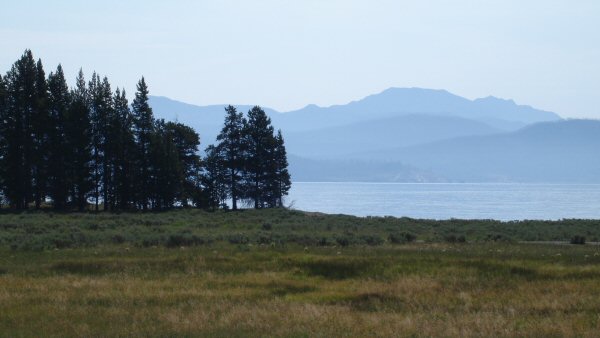
Lake Yellowstone
The Yellowstone River flows 671 miles on its course from Wyoming’s Shoshone Mountains to its eventual merger with the Missouri River and the Atlantic Ocean. The river flows north, starting at Fishing Bridge continuing over LeHardy Rapids, crossing Hayden Valley, tumbles over the Upper and Lower Falls in the Grand Canyon of the Yellowstone, to meet with the Lamar River at Tower Junction, then winds its way through Montana to join with the Missouri River in North Dakota. It is a spawning ground for Cutthroat Trout and is frequented by Bears and other creatures who love a good fish dinner 🙂
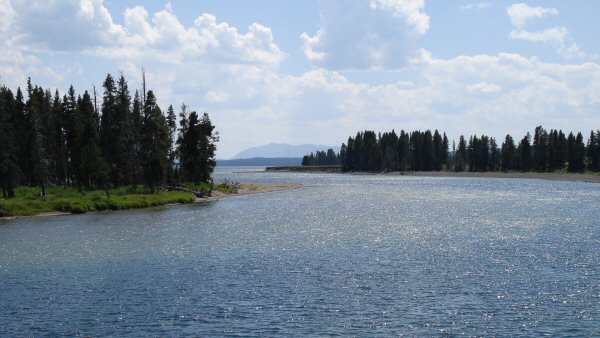
Yellowstone river at its source
Near Fishing Bridge, going in direction of Hayden Valley and Canyon Village, are very interesting geological features, the Mud Volcano and the Sulphur Cauldron. A unique
water system where the ground water boils away faster than it settles leaves Mud Volcano nearly devoid of water. As a result, numerous steam vents form that allow hydrogen sulfide gas vapors to escape from deep within the Earth’s surface. These vapors dissolve the area’s rock into clay and also combine with water and bacteria to form highly acidic pools. (PH 1.3 in the Sulphur Cauldron area, which is twice as acidic as battery acid) When these sulfur pools, carbon dioxide, steam, and clay join together, visitors are treated to a spectacular (and stinky) display of bubbling mudpots.
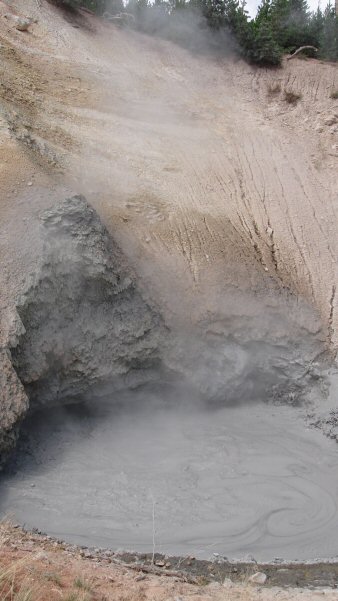
Mud Volcano
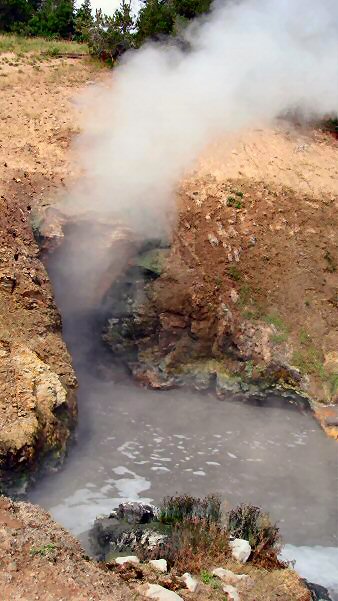
Dragon’s mouth spring belches and steams as 180 degree Fahrenheit water splashes in its underground cave.
Hayden Valley is where we saw the most Buffalos, it is also where we saw the most beautiful, bright, complete, absolutely amazing rainbow we’ve ever seen in our life. No pictures could ever do justice to that rainbow, but here is our attempt at capturing a rainbow for you guys.
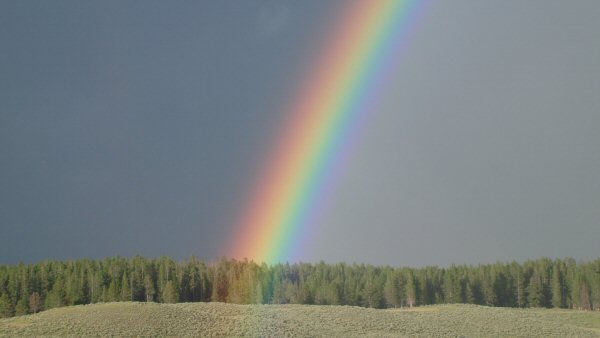
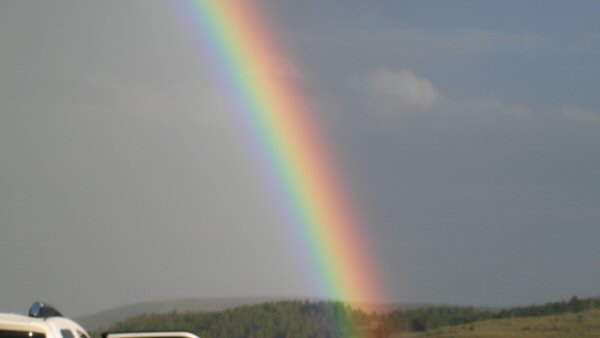
Canyon Village area The Grand Canyon of the Yellowstone, what a spectacular area, the canyon ranges in depth from 800 to 1, 200 feet and in width from 1500 to 4000 feet. Erosion is largely responsible for carving the canyon and its steep rock walls display a kaleidoscope of yellows, reds, gold and oranges. It is also very special since it also features thermal vents linked to an old geyser basin.
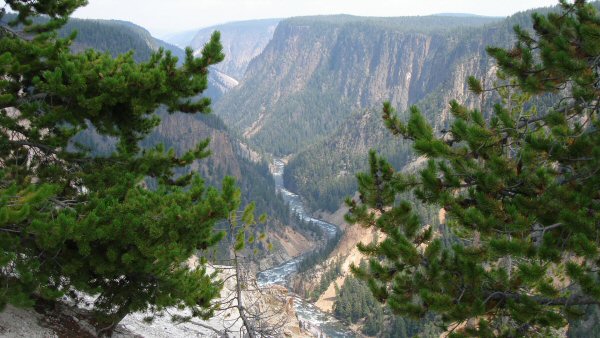
Grand Canyon of the Yellowstones
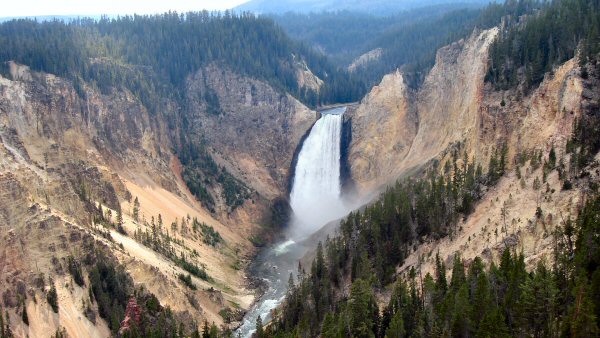
The Upper Falls
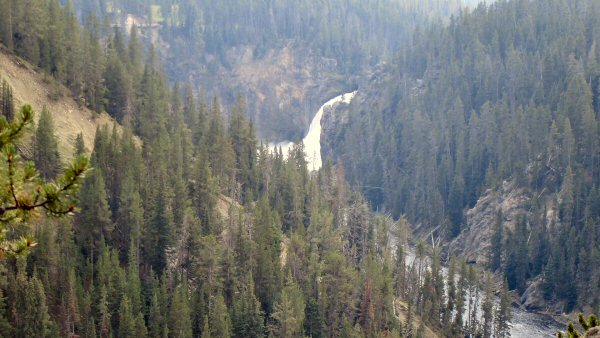
Lower Falls
The Mammoth Hot Springs area Going to Mammoth Hot Springs from Fishing Bridge, you cross the 45th parallel which is situated halfway between the equator and the north pole. The thermal waters surface at a nearly consistent 170 degrees F. Light-colored limestone known as travertine extends from Mammoth’s popular upper formations to the Boiling River near the park’s North Entrance. Sink holes dot the area, and evidence of volcanic forces and underground thermal activity is associated with a fault line paralleling the Mammoth Hot Springs/Norris highway.
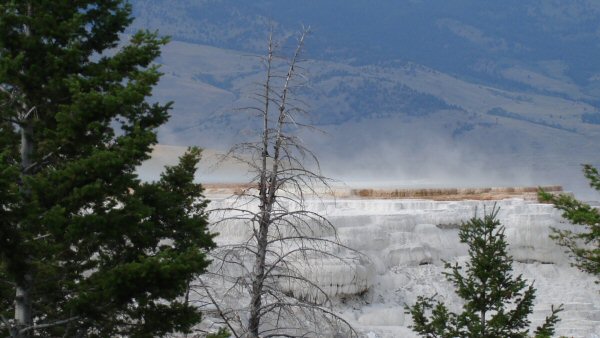
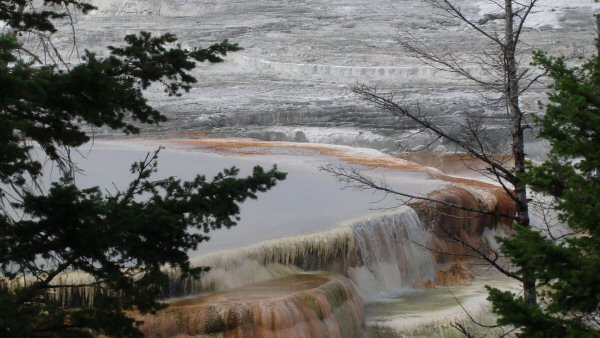
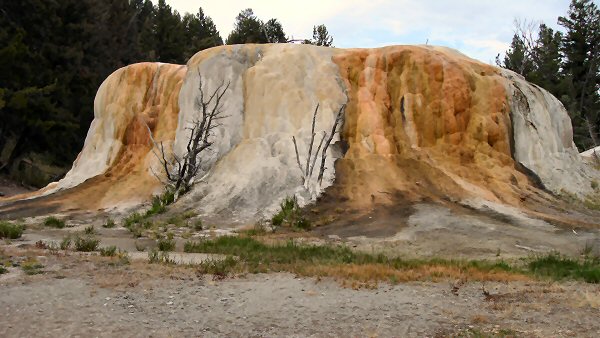
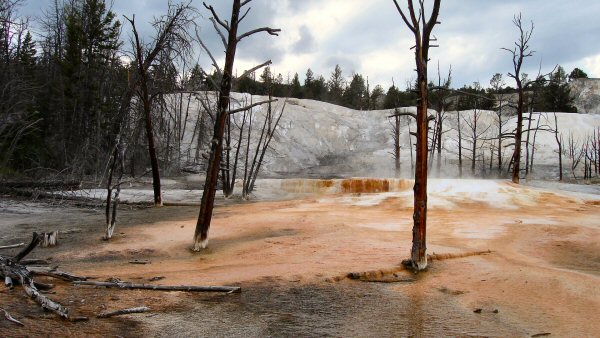
The Mammoth Hot Springs Terrace
The Geysers, hot pools, springs and fumaroles of Yellowstone
The area between West Thumb and Norris is the most geologically active area of Yellowstone Park, it features hundreds of geysers, hot pools, springs and fumaroles (steam vents), the most popular and well-known being Old Faithful, the very predictable geyser erupting approximately every 91 minutes.
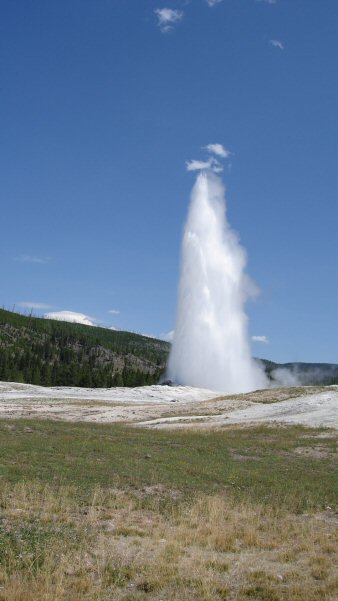
Midway Geyser basin

Excelsior Geyser
Excelsior Geyser releases over 4, 000 gallons of hot water every minute in the Firehole River. It was once considered Yellowstone`s most impressive geyser, but the sheer force of its eruptions was its downfall, the pressure destroyed its underground water piping system. It used to shoot water 300 feet in the air every 20 to 120 minutes. Today it is a 200 by 300 foot gaping crater that lies dormant.
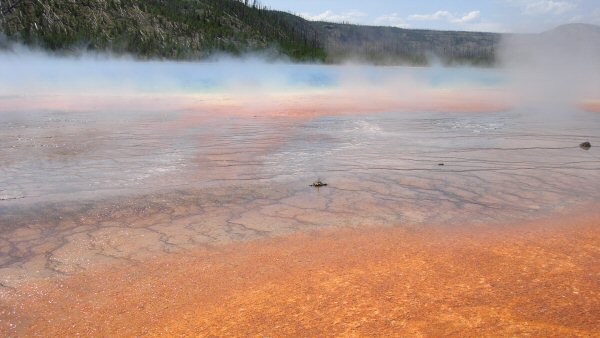
Grand Prismatic Spring
Grand Prismatic Spring. Featuring an abundance of beautiful water, Grand Prismatic is Yellowstone’s largest hot spring and the world’s third largest spring. The spring measures 121 feet deep with a diameter spanning 370 feet. The bright colors around the spring are caused by bacterial mats, colonies of bacterias thriving in hot water. The 160F water causes the spring to be engulfed in steam.
West Thumb and Grant Village area
This area is alive with geothermal activity, hot pools and fumeroles, it is also where you can find Iza lake with its east side draining to the Pacific and the
west side flowing into the Atlantic, Isa Lake is one of the world’s only lakes that drains backwards into two oceans.
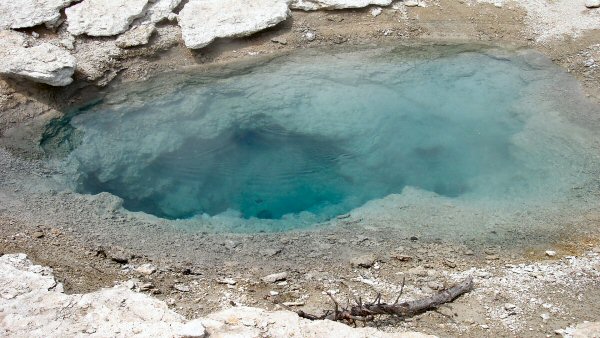
Hot pool in West Thumb area
The Wildlife
One of the pleasure of traveling through Yellowstone is the opportunities to see wildlife in their natural habitat. Bison are plentiful and elk are easy to spot, but wolves, bears, mountain lions, bighorn sheep, beavers, eagles etc. etc are a bit harder to spot. You usually know when there are animals to be seen when you see a traffic jam on the road, actually, there is no such thing as a traffic jam in Yellowstone, you either have a Bear Jam or a Buffalo Jam or an Elk Jam etc. etc.
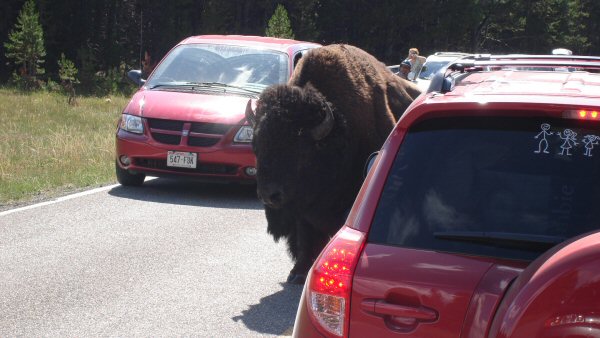
Buffalo Jam
The buffalo were in rut while we were visiting, they were very active and aggressive, and spent a lot of time crossing roads, grunting and drooling at the buffalo girls, who were not ready yet… very frustrating for a healthy buffalo you know….

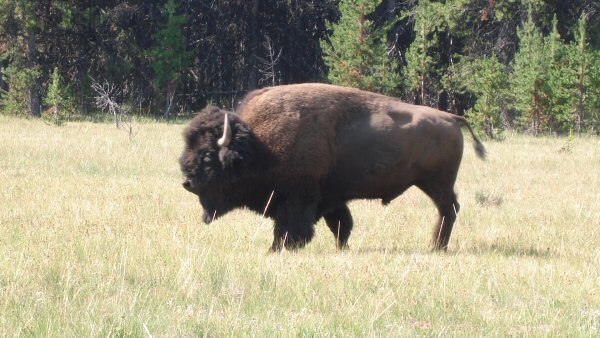
We were lucky enough to see an eagle, perched in a tree.

Eagle
An elk was leisurely drinking water out of a stream on the side of the road, absolutely not bothered by all the attention.
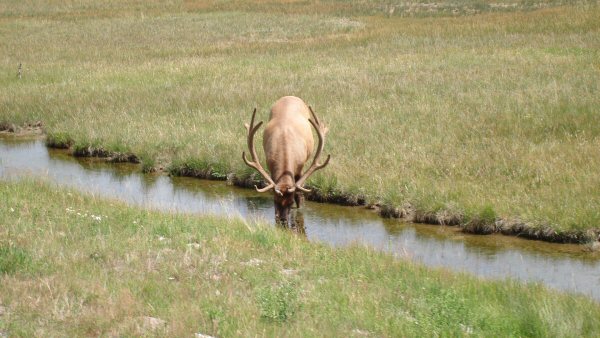
Elk
The bear and the coyote. One morning, we were taking a ride down from Fishing Bridge going towards the East entrance, we saw a lot of cars parked, so we stopped to investigate what was happening, there was a Grizzly bear, digging for something, nobody knew what he was actually looking for, but he was very busy digging, then a coyote sneaked in behind trees, very intrigued by what the bear was doing, he layed down in the tall grass, observing the bear for a while. He finally jumped up and started running at the bear, who spooked, started running towards the road, everybody ran for their cars, but then the bear stopped, and looked back, saw that what had spooked him so bad was a coyote, well… he was not a happy bear for sure, so he started running after the coyote, but quit the chase early and went back to digging his hole, the coyote came back, and stayed about 20 yards from the bear, observing, once in a while he would jump, and the bear would look threatening, that would calm the coyote down for a little while, then the whole thing would start again, we stayed there about 20 minutes, observing the interaction between this very busy Grizzly and this very inquisitive Coyote, that made our day!
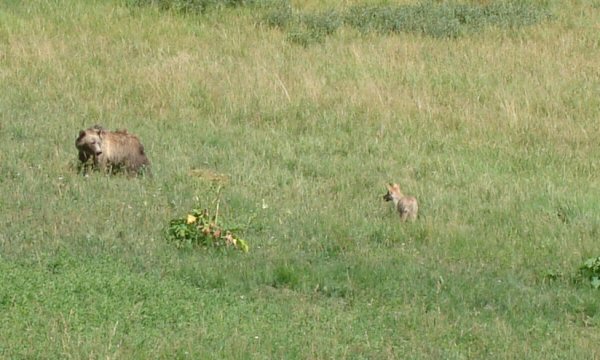
The bear and the Coyote
We didn’t have to go very far to see wildlife, we were told that a Coyote had given birth to a litter of puppies right before we arrived, there was a small herd of buffalo, about 12 individuals who liked roaming through the campground, bears were close and we were warned not to leave food out of the motorhome, and this deer leisurely cut across the campground just in front of our coach, two days in a row.

A few things to be aware of if you intend to go to Yellowstone Park; the West entrance from Idaho Falls is very tight, they are working on the problem, but in the mean time, two of the entrance booths have a 12’6″ clearance, and all of them are so narrow, there are multiple traces of impact on each sidewall from motorhome mirror hits. The East entrance is higher but as narrow, so it is very difficult to maneuver through. The best place to eat dinner is the Lake Hotel in Lake village, we had dinner at the Old Faithful Inn, it is a beautiful wood structure, food was fine but not extraordinary.